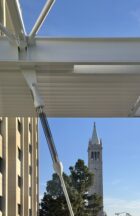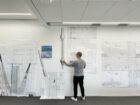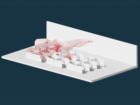Shape memory alloys (SMAs) are remarkable metallic materials with the ability to regain their original shape after being deformed due to temperature, stress, or strain. The applications of this technology have ranged from heart stents to spacecraft, but rarely has it been used in buildings.

In designing a comprehensive renovation and expansion for the Grimes Engineering Center at UC Berkeley, SOM seized an opportunity to use SMA technology to enhance the building’s resilience against seismic events. The design—an innovative system of tension rods with SMA cables—constitutes the first-ever use of SMA technology in a lateral force-resisting system in new construction. As a visible feature of the building’s structural system, the SMA cables become a signature element of the building’s identity.


The unique properties of SMAs come from their base metals, nickel and titanium. While traditional steel will permanently deform under small deformations, superelastic SMAs can undergo significant deformations without permanent damage—approximately 25 times than that of steel. Thus, they can bend and snap back to their original shape, acting more like a rubber band than traditional steel. The qualities of SMAs—repeatable, reliable behavior complemented by high corrosion resistance—make the technology suited to application in building structural systems.

The redesign of the Grimes Engineering Center, located a quarter mile from the Hayward Fault, presented an opportunity to advance the field of engineering with a visible system for seismic resilience. The lateral system employs interior buckling restrained braces complimented by a perimeter SMA tension rod system. The SMA material is composed into wire ropes reconciled into tension rods through connectors that were collaboratively developed with TriPyramid Structures. Prototype testing of the SMA tension rods was conducted in the neighboring Davis Hall’s Structures Lab. The tension rod system plays an important role in controlling the roof seismic drifts and minimizing demands on the existing foundations.







